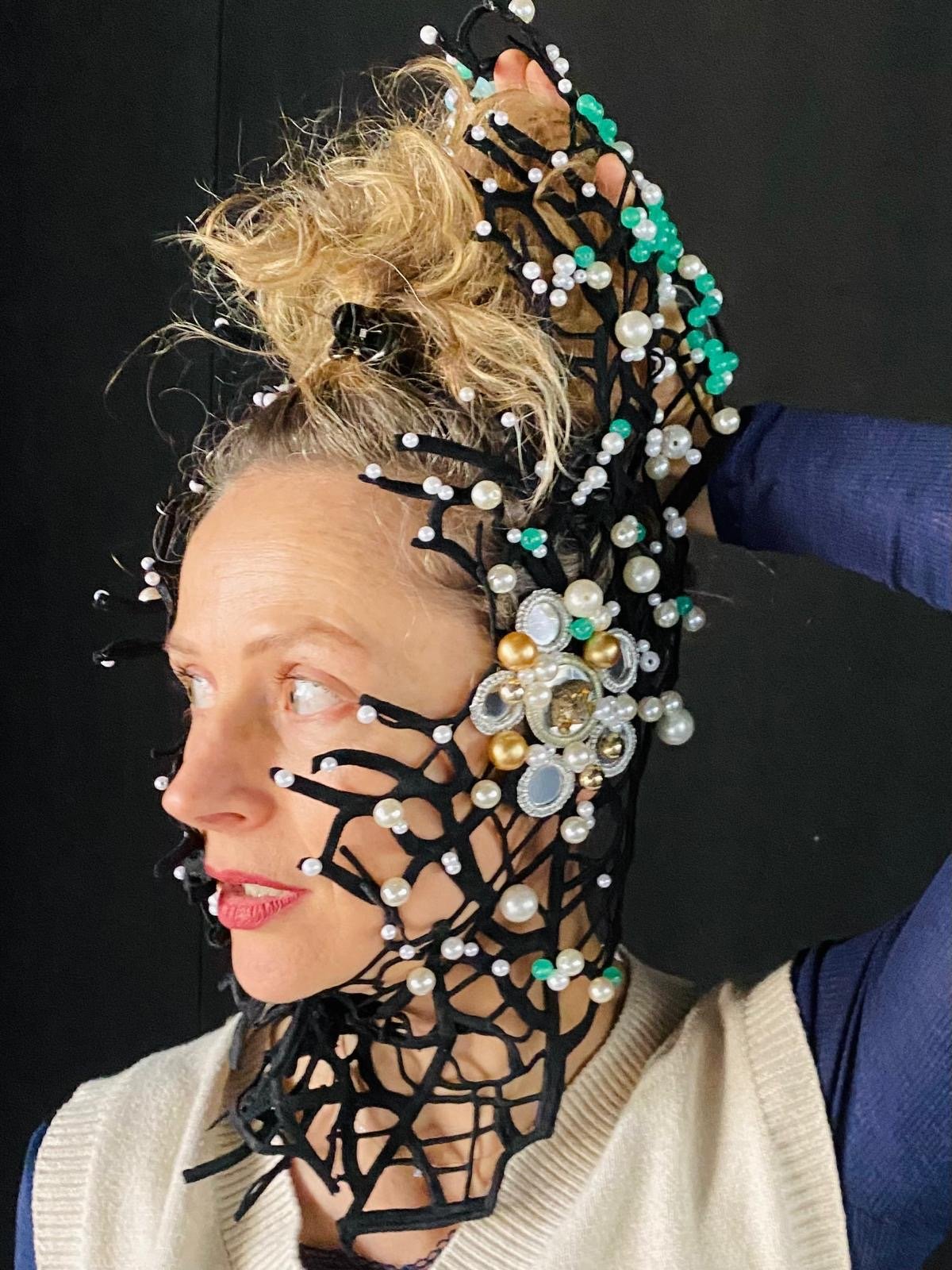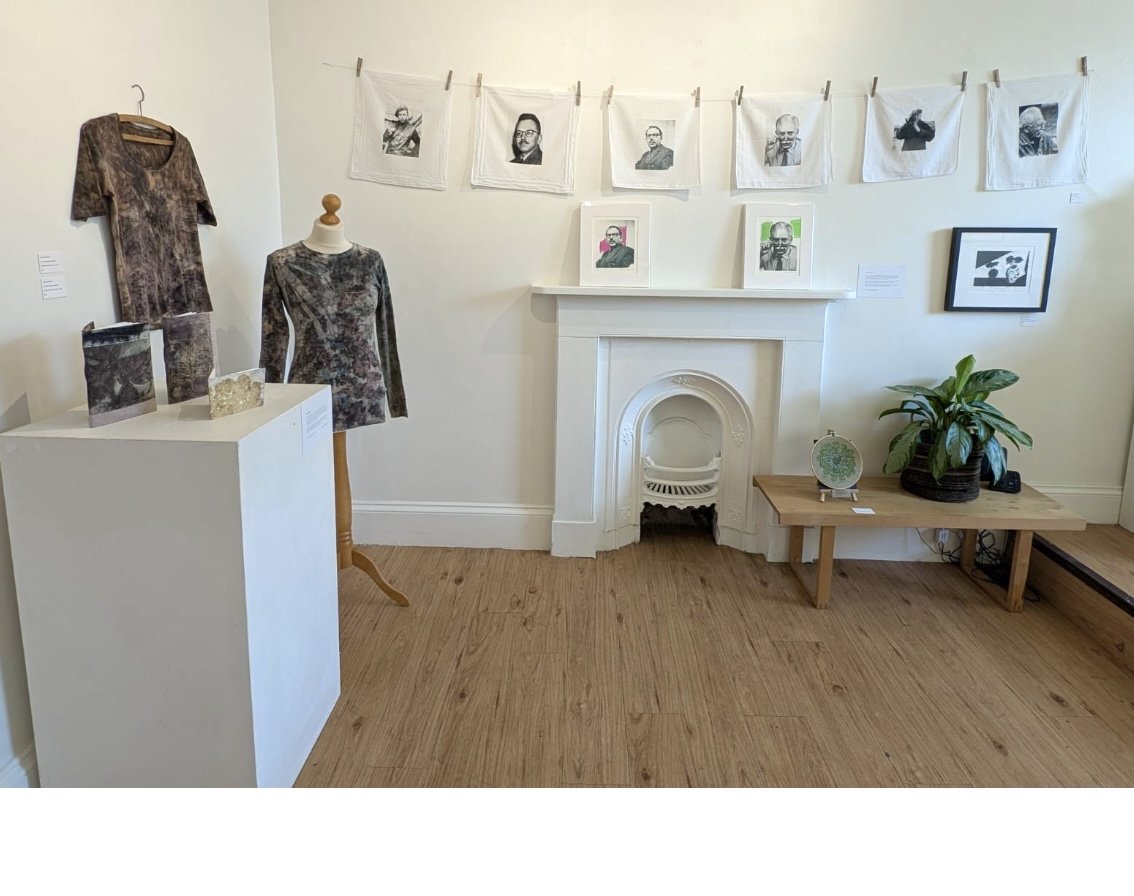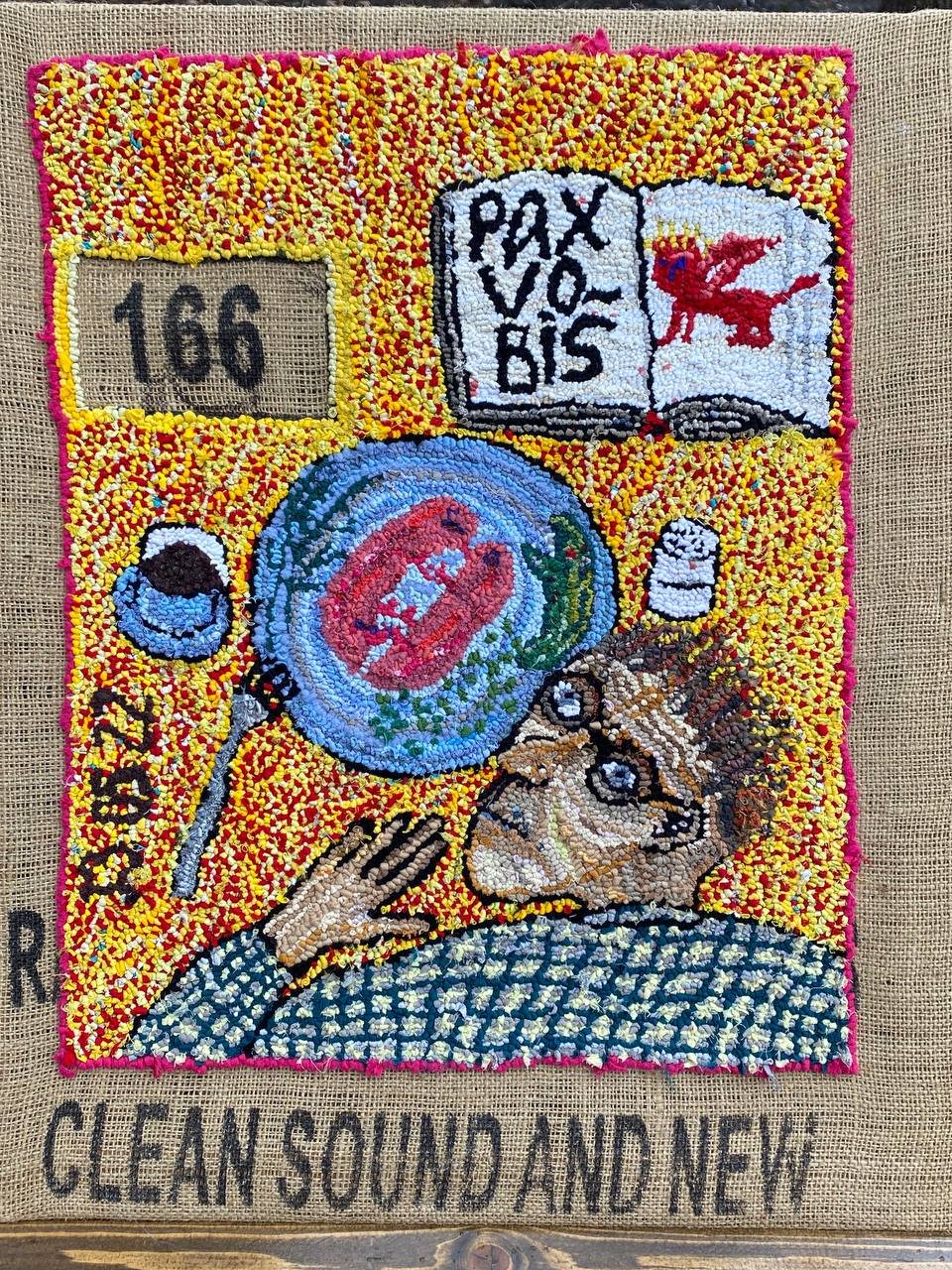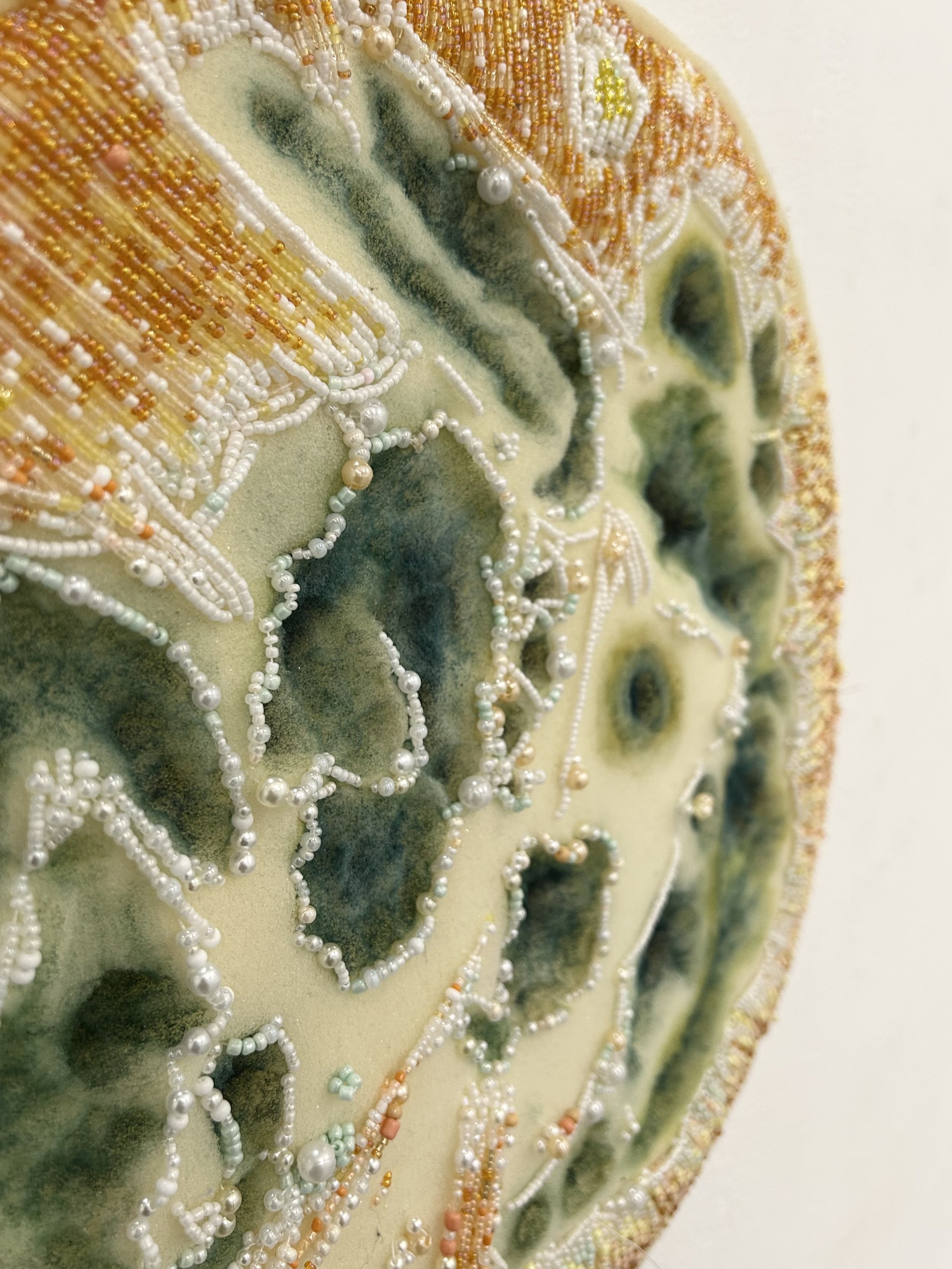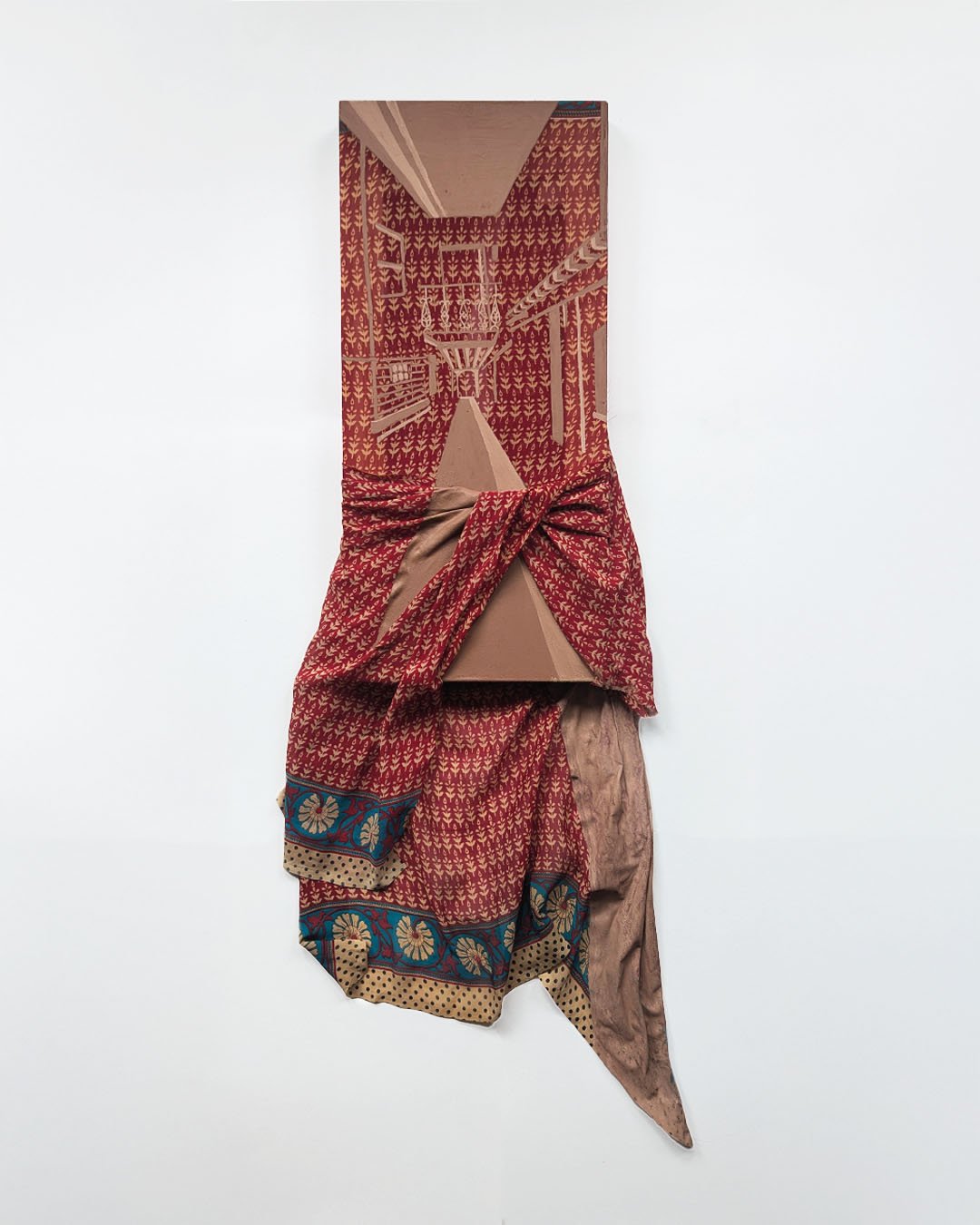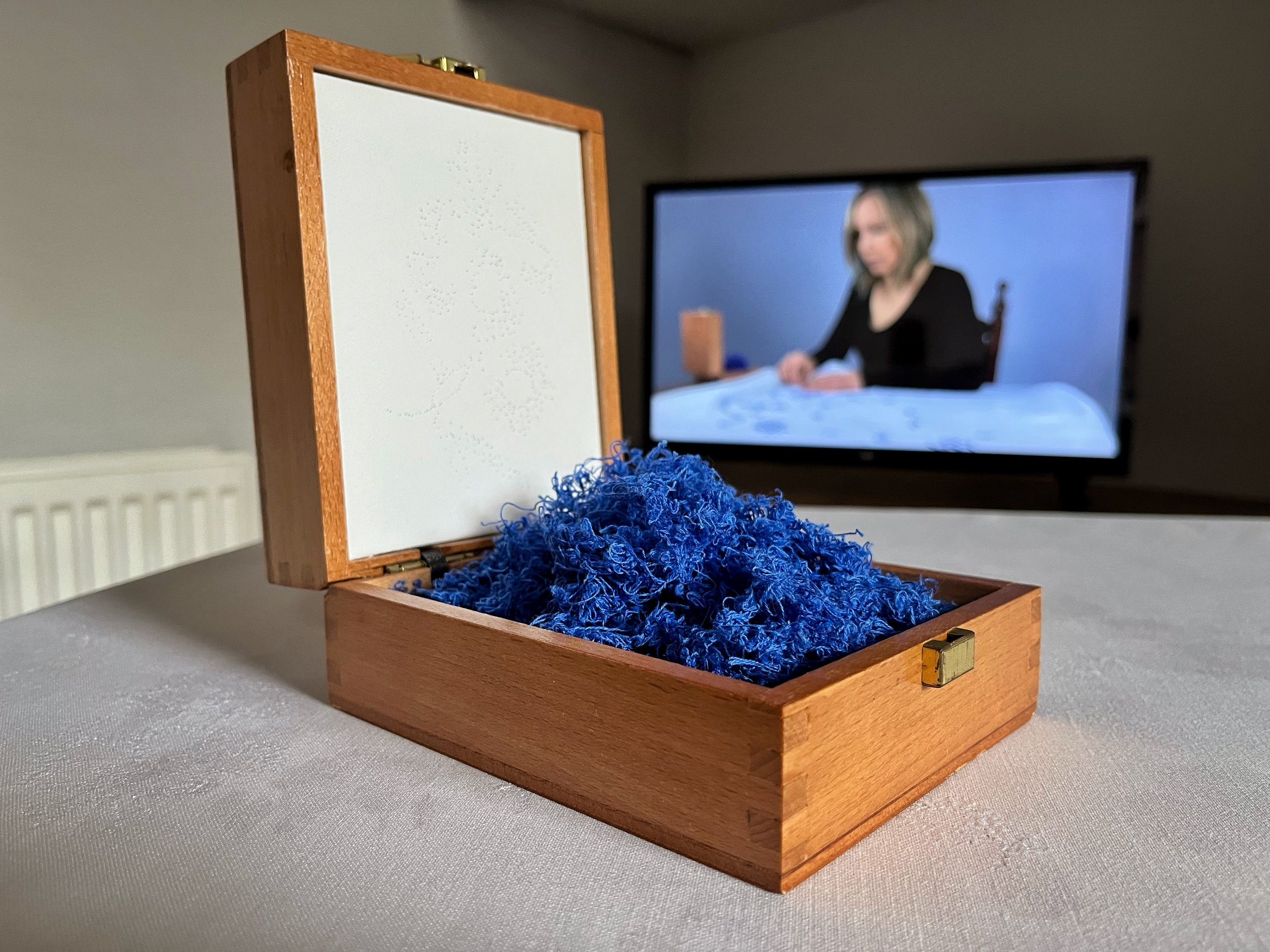For this issue, we asked for submissions from artists that use TEXTILES as part of their practice.
This open call sought creative interpretations that push beyond the literal and embrace textiles' complexity, meaning, and associations as a medium.
We asked artists to consider using textiles as material and to share how they use textiles in their creative practice and push the medium to its limits.
What processes are used to create textile art - is the process more important than the material, and how is it transformed into your finished work?
Textiles have an emotional and symbolic weight. We asked what textiles you signify in your work. Is there an emotional connection to the fabrics and how does your work play with this?
Are textiles full of metaphors of illumination and obscurity and what can we learn from the fabrics you used? Finally, how is their history and their context part of the work? Do the textiles you use have significance for their history, culture and political connections?
Artist: Micaela Vivero
@micaela_de_vivero
https://www.micaeladevivero.com/
Khipus. Description. Khipus were the main means of state record-keeping and communication during the Inka empire. During the colonization of the Americas, khipus were declared sacrilegious and they were destroyed in large numbers. Exhibiting these two fibre pieces inspired by Andean khipus in a church is a gesture to reclaim the right for khipus to exist.
Artist: Lara Buffard
https://www.larabuffard.com/
Sea Wave. Description. A headpiece crafted like a cresting sea wave, embroidered in shimmering threads upon delicate, light fishnet, encrusted with pearls, crystals, and fragments of sunken dreams.
Artist: Annie Brennan
anniebrennan_textiles
Dad’s hankies. Description. My father was a photographer, and I spent many hours helping him in the darkroom as a child. This set of photographic prints onto vintage hankies reflect his life.
Artist: Rina-Green Noodle
https://sites.google.com/view/a2galerie/artists/rina-green-noodle?authuser=0
Sound, Pure and New. Description: Rug hooking, burlap, textile 68 × 52 cm 2022.
Artist: Heather J Clarke
heatherclarke.eu
Le Féminisme n'a Jamais Tué Personne -Le machisme tue tous les jours
Description. Remembering the 21 women murdered by their partners in Belgium in 2024. Their names are sewn into this unfinished petticoat which symbolises a life unfinished. #NoExcuse Woman Life Freedom.
Artist: Priscilla Edwards
https://www.priscillaedwards.co.uk
Wing Collar Angel. Description: This is a mixed-media piece using wire, silk, wax, ceramics, acrylic paint, leather, a cotton collar, ink, and found materials. It explores our connection to angelic beings, making believe or real, questions that have raged through the centuries and continue to cause debate.
Artist: Miriam Habibe
http://www.saatchiart.com/account/profile/2648111 ; https://www.artpal.com/directpath07
The Spirit of Modernism.
Description: When I created "The Spirit of Modernism," I felt a deep pull to capture the essence of the modernist movement. This bold shift broke away from convention and embraced abstraction and innovation. This piece became my playground for exploring dynamic shapes, vibrant colours, and textured forms, all coming together to embody the spirit of liberation and progress. Fragmented geometric forms became a visual language, symbolising the freedom to defy traditional artistic boundaries. I chose a bold colour palette to heighten this sense of rebellion, juxtaposing bright hues against stark contrasts, where each colour and shape demanded attention and interpretation. It was an invitation for viewers to ponder their perceptions of reality. The interplay of materials added another layer of depth to the artwork. Fused glass reflected light with a glossy elegance, contrasting the intricate textures of woven textiles and the tactile appeal of layered paper. Each stroke of paint added energy and movement, creating a symphony where every element held its own yet harmonised beautifully. Through "The Spirit of Modernism," my goal was not just to challenge traditional boundaries of art but to celebrate the innovative spirit of our modern age. I wanted viewers to feel liberated—to experience art as an evolving dialogue between form, colour, and meaning. This piece is a testament to how tradition and transformation can coexist and spark profound emotional connections.
Artist. Rag*Treasure
https://www.hoelle.media/en/
Sharper Than A Needle #1.
Description: Sharper Than A Needle is an interdisciplinary project that merges textile art with experimental pop, sound art, and movement. The ensemble Dressed In Sound explores textile machines as sound sources, transforming spinning wheels, knitting and sewing machines, as well as modified notions and costumes into instruments. The concert premiered on February 23, 2025, at the Therese-Giehse-Halle of the Münchner Kammerspiele. The core ensemble includes Klaus Erika Dietl, Karen Modrei, Stephanie Müller aka Rag*Treasure, Lisa Simpson aka Agente Costura, and Stefan Wischnewski. Guest artists include wheelchair dancer Sema Schäffer, drummer and dancer Ángela Muñoz Martínez, noise sculptor Max Weisthoff, experimental filmmaker Dafne Narvaez Berlfein, and eight textile artists from the network Beyond Textile, who form a choir on prepared sewing machines.
Artist: Nelson
@_nelson_leaks
https://www.nelsoncontemporaryart.com/
The Ties that Bind.
Description: Mixed media, primarily hand and machine-sewn textiles, 270cm x 150cm x 10cm What can we inherit from the generations before us? Eye colour and face shape indeed, but what else? Situation and context? Memory and pain? A propensity to violence or to creativity? "The Ties that Bind" is a self-portrait of the fractured and leaking versions of my "self" shaped by my personal history and the memories I can't let go of. Each self is in constant tension as I try to be more than, perhaps better than, possibly cured of, the things I inherited. The poem "Inheritance" was written to sit alongside this work.
Artist: Nancy-Violet Downs
nancyviolet.com
Suncatcher.
Description: Suncatcher is a textile flag activated through a sunrise parade for the 2025 spring equinox. Made for Wedontknowwhatthisis sunrise gathering (taking place every equinox and solstice on Hackney Marshes), the flag invites the ritual of holding up to the sun to allow it to pass through, honouring the cycle and marking our journey in the rhythm of the cosmos. Echoing the alignment of Stonehenge with the solstice sun, suncatcher allows us to reconnect with the seasons and each other, working together to hold the flag up to the sky in a simple act of re-enchantment.
Artist: Beth Barlow
www.bethbarlow.com
"Unpicking"
Description. A way to sit in grief and start to understand how something so solid as a Dad can become nothing.
Artist: Rosalind Lowry
www.rosalindlowryartist.com
Endangered Species List 481
Description: An Irish Linen textile installation in Lagan Meadows, Belfast. Each of the 481 species on the red list for Ireland is represented in a pile of discarded shapes. Passers-by are encouraged to take a species home to care for it and champion its cause. Both Irish Linen and the 481 species are endangered. At the end of the 2 week installation all of the linen pieces had gone.
Artist: Catherine McColgan
Aspergillus. Description: Aspergillus is an artwork comprised of beaded foam and paint, depicting a petri dish that the artist cultivated, which went mouldy. The beads capture the mouldy detail, juxtaposing the usual disgust we instinctively have towards fungus with beautiful pearlescent beads. Each bead is sewn into the foam, emulating how hyphae penetrate their landscape as they digest it.
Artist. Ivy Weiyi Chen
Untitled. Description: This work is from my knitted sculpture series “Lingering”, which explores the contradiction between fragility and strength in East Asian mother-daughter relationships using textile as a main medium. This piece is my imagined perspective of the moment I was born—when I began to see our connection not just as a daughter, but through my mother’s eyes. Suspended between reality and dream, I placed this sculpture in a liminal space, oscillating between past and future, constraint and escape. Like a daydream, it wavers between fragility and strength, revealing the invisible forces that shape identity, memory, and emotional ties.
Artist: Karen Fox Jewellery
www.karen-fox.co.uk www.craftscouncil.org.uk/directory www.bluecoatdisplaycentre.com/makers www.findamaker.co.uk/karen-fox-jewellery/maker www.acj.co.uk
Ruffle Neckpiece
Description: Karen takes elements from traditional craft techniques inherent in her West Country roots and the subtle influences from growing up with an engineering & artistic family. The stainless steel wire cloth is an engineered techno fabric woven on a loom and used in the aerospace industry. The fabric has been double pleated or ruffled - often lined to enclose the sharp edges - and then stitched, creating a richly layered textured surface. A heavier gauge steel mesh is used for the pleated cuff to create a more structured look. These are recurrent processes in her work that make subtle changes in the surface of the cloth - a beautiful iridescent quality, changes in tone and texture and undulating forms, and is she says "the result of many months of experimentation with this beautiful and often unforgiving material. I love the idea of an engineered techno-fabric being used in an historical context". Karen's influences stem from architecture for its structure, geometry and repetition and historical dress design - the Tudor era in particular for its fine detailing and dramatic scale. The often extravagant layers create an opulent feel, recalling a time of exaggeration and decoration and reflecting the spirit of her research, alluding to the past but innovative and timeless.
Stainless-steel wire-cloth, linen, cotton thread. See Biography section for full description.
Artist: Susan J Hart
www.susanjhart.art
Windswept Dreams
Description: Part of a small but developing body of work that uses textiles as a means of exploring self-perception and emotion. I'm particularly interested in whether or not the quality and behaviour of fabric can represent human emotion in a comparable way to the emotion typically expressed by face and limbs. Is such a display of emotion possible with the omission of face, hands and feet? Whilst the body in this piece is present, none of it is visible. There's a sense of the material moving over the shape beneath, emphasising parts of it, whilst concealing others. So is it the body that expresses the emotion from beneath the fabric? How important is the fabric in accentuating such emotion, and could the fabric express emotion without the presence of a body shape?
Artist: Rachel Young
www.instagram.com/ctcthephd/
(RE)Material. Description: (RE)Material is an ongoing project featuring tactile, leather-bound paper notebooks measuring 20cm x 15cm. Weeks 9 & 10. Each notebook is divided into weeks and includes fragments of old garments, costumes, and emerging projects, creating a narrative experience through various textures and forms. Each page hosts a short journal entry representing a week of inquiry of the PHD ‘Costuming the Collapse’. Each week of the 365-week process is linked to a specific fabric fragment encountered during that time. These overstuffed notebooks draw inspiration from the books used by costume professionals, which contain fabric swatches, dye samples, budgeting notes, and scheduling details. They serve as tools for continuous engagement with materials, embodying a process of creation rather than a final product. While traditional costume production files or "costume bibles" document the entirety of a project, these notebooks remain unfinished and evolving, representing a vigorous materiality. The act of creating these weekly sample books has shifted focus from the end product to an ongoing exploration of materials. Collecting and collating materials has become a method of sense-making. Viewing fabrics as collaborators in the creative process aligns with Jane Bennett's idea of ‘Lively Matter’, highlighting the significance of inanimate objects in our inquiries. Ultimately, these notebooks serve as companions in my exploration, offering insights that transcend traditional academic research, revealing the profound knowledge that tactile experiences can provide. These notebooks are amongst a constellation of work as part of the PHD ‘Costuming The Collapse’ A post-qualitative, posthuman investigation into the degradation of the natural environment through performance costume.
Artist: Imogen Patel
imogenpatel.com
Not that pub .2. Description: Acrylic on Sari 32 x 103 cm 2024. This piece explores the uneasy relationship that the global majority communities often have with traditional pub environments. Using the outlines of an alleyway, the composition leads the viewer’s eye backwards, creating a looming, vulnerable feeling. The sari fabric drapes heavily from the canvas, with painted folds adding weight and density to the image, mirroring the emotional heaviness and dragging sensation experienced in such spaces.
Artist name
Zane Zeivate
www.zanezeivate.com
Scaffolding Series - Carrying
Description: 2023, fabric, water pipes, pipe insulation, polyester fibre, steel, 230cm x 40cm x 52 cm I am fascinated by creating ladders that seem impossible to climb. They may appear inviting, especially to the smaller viewers, but it quickly becomes clear that they won’t take you far, as they are filled with various metaphorical distortions. Ladders, which in society's understanding symbolise progress, in my creative process become a way to question the everyday actions that we accept as the path to progress. These ladders are a work from an ongoing series - Scaffolding Series. With these works, I try to reshape the details of scaffolding structures that are normally made of galvanised steel. By using fabric, I underline the potential multiplicity of form and possibilities that the object can take and accumulate within itself. Understanding scaffolding as a masculine short-term space-occupying public space - I use it as a metaphor for structures in law that are made to ( for men) and as an opportunity to talk about female bodily emancipation.
Artist: Blair Martin Cahill
https://www.blaircahill.com/
The Marquis.
Description: Embroidery on Silk. In the late 1600s, a notorious figure known simply as "The Marquis" held sway over the high seas and noble courts alike. Born to both the nobility and the ocean’s depths, he possessed a glistening fish tail below his waist, a gift—or perhaps a curse—of his sea-bound ancestry. His life was a scandalous blend of decadence and debauchery, filled with high-stakes gambling, raucous champagne-fueled gatherings, and bawdy limericks that had a way of leaving his audiences both shocked and charmed. This eccentric Marquis was a regular at every dimly lit tavern and opulent salon, always spinning tales of exploits about his beloved ship, the HMS Piscaria. Manned by fish-like sailors of fierce loyalty and stranger origins, the Piscaria roamed the seas in pursuit of treasure and revelry. Together, this strange, seaworthy crew painted the coasts in hues of salt and scandal, leaving legends of their daring escapades whispered in every port.
Artist: Mandy Nash
https://mandynash.co.uk
Comforter sculpture/brooch 2022. Description: My work is created to subconsciously entwine my observations of my travels and the world around me. endeavouring to evoke an emotional response, whether directly or indirectly, using colour and pattern to create a mood. I find sanctuary in the meditative, feltmaking process, which allows time for reflection, and I gain great joy when my work stimulates a similar connection. In reaction to the pandemic and inspired by the phrase, 'if you touch something good, you feel good', by exploiting the tactility of felt to comfort and console, I created a series of brooches/sculptures. They are intended to be worn and touched when in need of comfort. They have removable pins, so they can also become a small sculpture. Using differential shrinkage, these tactile forms start as flat pieces and miraculously become three-dimensional as they are felted. My hands are my most important tools and I use them to manipulate the felt until I am content with the form. Working with wool has many advantages, it can be re-wetted and re-manipulated into different forms. Nothing is fixed. The making process is more important than the finished product, it is important to respect the slow process of creating textiles, the hours of stitching and the patience that went into creating the textiles of the past. I collect these pieces abandoned in charity shops, sometimes incorporating them in my work, so they are not forgotten. Textiles can be recycled and given a new life, vital in this world of fast fashion.
Artist: Nisaa Saeed Raja
https://readymag.website/u4278856910/nisaasaeedraja/?fbclid=PAZXh0bgNhZW0CMTEAAaco_A5IGZf3jtRKsg4v9tHB0Z5BonOGcpDWEO7Ec3GatK1ZDJiFh7Jk-3I4YA_aem_SN96cn7PKLaKQGfMEZIASg
Tarpal/Canopy (installation at top), 2020 - Unees Bees series (wall pieces at bottom), 2020. Description: My work bridges personal narratives with collective memory, creating a dialogue between materiality and the intangible experiences of migration, loss, and transformation. Through process-based methods of construction and deconstruction, I repurpose everyday objects—particularly garments—to explore shifting notions of identity and belonging. By altering the familiar, I aim to preserve cultural essence while questioning the frameworks that define ‘home’ in an ever-changing world. The phrase Unees Bees, which translates from Urdu as “19 and 20,” meaning “a minor difference,” informs my approach to subtle transformation. Often used in a sartorial context, it reflects how small changes in appearance or structure can carry deep significance. In my work, this is expressed through the reconstruction of traditional garments like the shalwar kameez. These alterations, though minimal, challenge the garment’s original function and symbolism, mirroring how minor societal shifts can disrupt identity, memory, and cultural continuity. The deconstructed garments become metaphors for fragmentation—of the self, of tradition, of belonging. They speak to the layered complexities of navigating bourgeois, patriarchal, and diasporic systems that often go unquestioned. By exposing and reconfiguring these layers, I reflect on both personal and shared experiences of dislocation and adaptation.
Artist: Yuyang Chen
https://chenart.cargo.site/
It will never be the same
Description: It Will Never Be the Same is a fabric-based sculpture incorporating fabric inspired by the artist’s security blanket stitching with childlike drawings and second-hand furniture. The work draws inspiration from the artist’s childhood security blanket, a gift from her grandmother that she could not sleep without. The blanket carries the comforting scent and softness of memory. Beyond symbolising the traditional female role passed from one generation to the next, it also serves as a personal anchor, offering a deep sense of security and identity. The textile element unfurls from the lamp to the bed like a shadow, trying to cover and protect memory. Yet, the piece also evokes a quiet sense of absence and loss: while the objects endure, time and memory remain irretrievable.
Artist: Andia Coral Newton
https://andiacoral.com/
Cathedral for Women with Mental Health Issues (2024)
Description: Machine-woven Tapestry: recycled PET, linen, cotton and mohair wool & bespoke walnut frame This work was made in collaboration with the programmers and weavers at TextielLab. The Cathedral is a liminal space of reflection on how much of yourself you can afford to share in an artwork. You may fall afoul if you stray from the pedestal. Here, the fear of oversharing and the excitement of new ways of expression combine into a lightning storm of existential dread and creative promise. No risk, no reward. A computerised jacquard loom lends a more intricate approach to image making around formal tapestry composition and subjects who would not be seen in traditional pieces.
Artist: Ross Belton
moderneccentrics.com | rossbelton.myportfolio.com | moderneccentrics.wordpress.com/category/ross-belton
Ukhamba
Description: Inspired by the ‘Ukhamba’, a traditional Zulu ceremonial beer pot, rimless and made from unfired clay, with ‘sgraffito’ marking. I’ve liked the idea of taking something very basic, for these a wow bandage (white open weave) and building up multiples to create something larger. I use redundant blacksmith tools to create the rust marks on the bandage, The contact printing process will rust mark the gauze, leaving traces of the tools’ previous use. Once the rust print has developed, I start shaping the bowl, using a starch paste. To hold the shape, I stitch the gauze, using cotton thread that I know will react in the natural dyeing process, so the holding stitching will disappear into the background when dyed. In these examples, I’m using logwood dye, which, without a mordant, will give a grey colour, but if mordanted, will yield a purplish colour. After extracting the colour from the logwood to create a dye bath, the bowls are simmered for about 45 minutes. When I reform the shape, where the rust mark appears, the logwood turns purple to black. This is caused by the tannin-iron complex, which I use frequently in my work. After the bowl has been formed again, I add the decorative stitching, echoing the sgraffito markings of the Ukhamba. In the photo for one of the bowls, I’ve not used plain gauze but created a rust watercolour which I’ve painted on as surface decoration. In the textured bowl, I’ve mordanted with alum, but used various types of thread which will dye the same colour but offer a different tone or texture. In the very dark bowl, I’ve used a high concentration of rust marking, which takes the logwood into a purplish black colour. Process feature www.textileartist.org/print-textile-art.
Artist: Jacqui Barrowcliffe
www.jacquibarrowcliffe.com
Invisible threads
Description: The memory of a stitch, of the hand that sewed it, of the stories it told. A video installation recording the process of unpicking a hand-embroidered tablecloth, inspired by the narratives and memories fabric holds. First developed on residence at an old textiles mill, the piece offers an intimate study of the intangible nature of everyday narratives, and the record they leave in the domestic setting and household objects. Memories of such stories are explored through the laborious process of unstitching a tablecloth and considering its personal history. The work, however, also considers the narratives on a wider scale in the context of the traditional role of the woman as homemaker and the relationship of women and cloth throughout history and across cultures. Through a process of undoing, the memory of those stories reveals itself in the small holes left behind in the cloth, ghostly traces of the stitches and the untold stories behind them. The installation piece consists of a table, the unstitched tablecloth, a small wooden box with threads inside, a photograph in an embroidery frame, and a video of the unpicking process. The piece has also been shown alongside a performance of the unpicking, and is currently being exhibited with a participatory element, where visitors are invited to share their own textile-related memories on scraps of cloth. Further information on the project can be found here:
https://jacquibarrowcliffe.com/portfolio/invisible-threads



